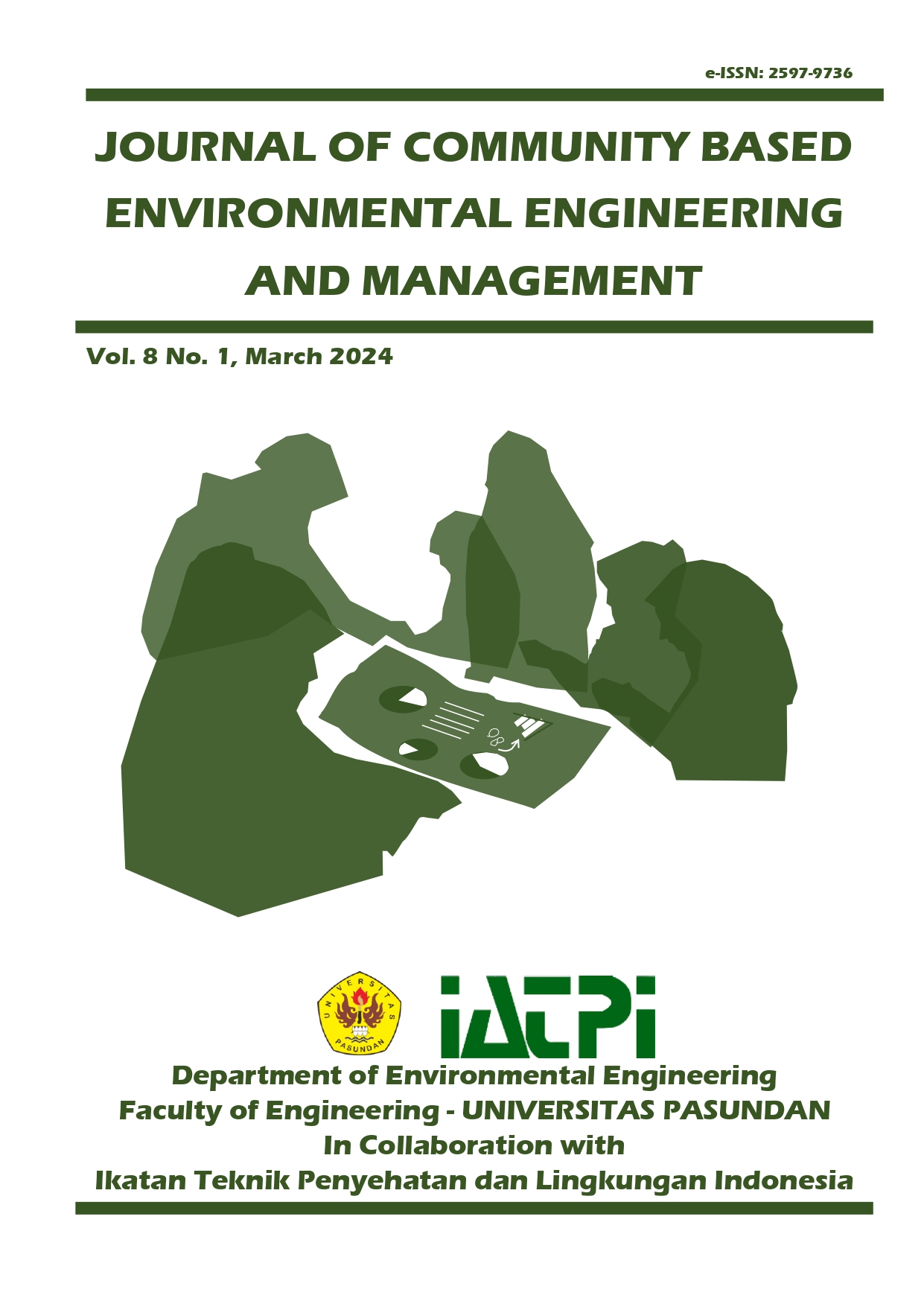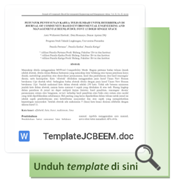Performance of Rapid Sand Filter Dual Media for Microplastic Removal in the Water: The Effect of Microplastic Size and Effective Size of Filter Media
DOI:
https://doi.org/10.23969/jcbeem.v8i1.12502Keywords:
microplastic, rapid sand filter dual media, silica sand, drinking waterAbstract
Microplastics (MPs) significantly damage the environment and human health, leading to a growing global concern. MPs have been detected not only in the natural environment but also in the drinking water treatment process. One of the configurations of the drinking water treatment unit is filtration. Only a few research studies have been published on microplastic removal in the water system. This study was conducted to determine the performance of a rapid sand filter (RSF) in removing microplastics in water with a variation in the effective size (ES) of silica sand and microplastic size. In this study, microplastics are artificially made with size variations of < 400 μm and >400 μm. The filtering uses two variations in the adequate size (ES) of silica sand, namely 0.4 mm and 0.7 mm. At the same time, anthracite is only a control variable with ES = 0.69 with a flow speed of 4 m / h and an observation time of 30, 60, 90, and 120 minutes. The results show that the filter media ES 0.4 has the highest efficiency values of 91.30% for the microplastic size MPs <400 µm and 95.80 % for the larger microplastic >400 µm. In addition, the average percentage removal of ES 0.7 mm was 77.24 % for the size of MPs <400 µm and 95.77% for the size of Mps >400 µm. Gaining insight into the mechanisms involved in removing microplastics from drinking water is essential for developing more effective techniques for eliminating them.
Downloads
References
, G. R. (2008). Particle density (pp. 504–505). https://doi.org/10.1007/978-1-4020-3995-9_406
Cescon, A., & Jiang, J.-Q. (2020). Filtration Process and Alternative Filter Media Material in Water Treatment. Water, 12(12), 3377. https://doi.org/10.3390/w12123377
Chabi, K., Li, J., Ye, C., Kiki, C., Xiao, X., Li, X., Guo, L., Gad, M., Feng, M., & Yu, X. (2024). Rapid sand filtration for <10 μm-sized microplastic removal in tap water treatment: Efficiency and adsorption mechanisms. Science of The Total Environment, 912, 169074. https://doi.org/10.1016/j.scitotenv.2023.169074
Chubarenko, I., Bagaev, A., Zobkov, M., & Esiukova, E. (2016). On some physical and dynamical properties of microplastic particles in marine environment. Marine Pollution Bulletin, 108(1–2), 105–112. https://doi.org/10.1016/j.marpolbul.2016.04.048
Crawford, C.B. and Quinn, B. (2017) Plastic Production, Waste and Legislation. In: Crawford, C.B. and Quinn, B., Eds., Microplastic Pollutants, Elsevier Science, Amsterdam, 39-56. https://doi.org/10.1016/B978-0-12-809406-8.00003-7
Huang, D., Tao, J., Cheng, M., Deng, R., Chen, S., Yin, L., & Li, R. (2021). Microplastics and nanoplastics in the environment: Macroscopic transport and effects on creatures. Journal of Hazardous Materials, 407, 124399. https://doi.org/10.1016/j.jhazmat.2020.124399
Lastovina, T. A., & Budnyk, A. P. (2021). A review of methods for extraction, removal, and stimulated degradation of microplastics. Journal of Water Process Engineering, 43, 102209. https://doi.org/10.1016/j.jwpe.2021.102209
Mintenig, S. M., Löder, M. G. J., Primpke, S., & Gerdts, G. (2019). Low numbers of microplastics detected in drinking water from ground water sources. Science of The Total Environment, 648, 631–635. https://doi.org/10.1016/j.scitotenv.2018.08.178
Novotna, K., Cermakova, L., Pivokonska, L., Cajthaml, T., & Pivokonsky, M. (2019). Microplastics in drinking water treatment – Current knowledge and research needs. Science of The Total Environment, 667, 730–740. https://doi.org/10.1016/j.scitotenv.2019.02.431
Pivokonsky, M., Cermakova, L., Novotna, K., Peer, P., Cajthaml, T., & Janda, V. (2018). Occurrence of microplastics in raw and treated drinking water. Science of The Total Environment, 643, 1644–1651. https://doi.org/10.1016/j.scitotenv.2018.08.102
Reynolds, T. D., & Richards, P. A. (1996). Unit Operations and Processes in Environmental Engineering. PWS Publishing Company.
Ryberg, M. W., Hauschild, M. Z., Wang, F., Averous-Monnery, S., & Laurent, A. (2019). Global environmental losses of plastics across their value chains. Resources, Conservation and Recycling, 151, 104459. https://doi.org/10.1016/j.resconrec.2019.104459
Sembiring, E., Fajar, M., & Handajani, M. (2021). Performance of rapid sand filter – single media to remove microplastics. Water Supply, 21(5), 2273–2284. https://doi.org/10.2166/ws.2021.060
Shen, C. C., Petit, S., Li, C. J., Li, C. S., Khatoon, N., & Zhou, C. H. (2020). Interactions between smectites and polyelectrolytes. Applied Clay Science, 198, 105778. https://doi.org/10.1016/j.clay.2020.105778
Sutkar, P. R., Gadewar, R. D., & Dhulap, V. P. (2023). Recent trends in degradation of microplastics in the environment: A state-of-the-art review. Journal of Hazardous Materials Advances, 11, 100343. https://doi.org/10.1016/j.hazadv.2023.100343
Tchobanoglous, G., Burton, F. L., Stensel, H. D., & Inc, M. & E. (2003). Wastewater Engineering: Treatment and Reuse. McGraw-Hill Education.
Thushari, G. G. N., & Senevirathna, J. D. M. (2020). Plastic pollution in the marine environment. Heliyon, 6(8), e04709. https://doi.org/10.1016/j.heliyon.2020.e04709
Verla, A. W., Enyoh, C. E., Verla, E. N., & Nwarnorh, K. O. (2019). Microplastic–toxic chemical interaction: a review study on quantified levels, mechanism and implication. SN Applied Sciences, 1(11), 1400. https://doi.org/10.1007/s42452-019-1352-0
Widianarko, Y. B., & Hantoro, I. (2018). Mikroplastik dalam Seafood dari Pantai Utara Jawa. Universitas Katolik Soegijapranata, Semarang.
Wulandari, M., Prasaningtyas, A., Ma’arij Harfadli, M., & Handayani, A. M. (2021). Distribution of Microplastic at Sediment on Balikpapan Coastal Area. Jurnal Presipitasi: Media Komunikasi Dan Pengembangan Teknik Lingkungan, 18(1), 153–160. https://doi.org/10.14710/presipitasi.v18i1.153-160.














